Program 1
Renovating Farm Houses
(Noson jutaku kaizen)- 1941 / B&W / 16mm / 20 min (postwar version)
Director: Noda Shinkichi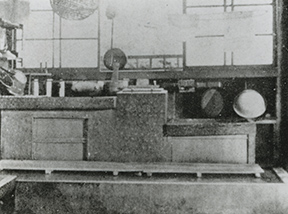
Image Courtesy of National Film Archive of Japan
Photography: Fukuda Saburo
Editing: Yamada Kozo
Music: Hattori Ryoichi
Supervisor: Takeuchi Yoshitaro
Production Companies: Toho Culture Films Department, Educational Film Makers’ Cooperative (postwar version)
Source: National Film Archive of Japan
Based on a study by the architect Kon Wajiro, who is also remembered as the originator of “modernology,” this film presents problems involving rural farmhouses in the Tohoku region as well as strategies for improving them. This extant version is the postwar release print, but it remains a valuable representative of Noda’s wartime production activities, which can be regarded as the starting point of his career.
Festivals in Tohoku Part 1
(Tohoku no matsuri: Dai 1 bu)-
1956 / Color / 35mm / 11 min
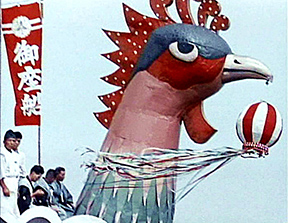 Director, Script: Noda Shinkichi
Director, Script: Noda Shinkichi
Photography: Uematsu Eikichi
Music: Mitsukuri Shukichi
Planning: Tohoku Electric Power Co., Inc.
Producer: Okada Sozo
Production Company: Tokyo Cinema Co., Inc.
Source: National Film Archive of Japan
This film documents the shishi odori (deer dance) performed by farmers in Akita Prefecture’s Hanamaki who dance around shrines and homes to ward off evil. It also documents the Minato Festival (port festival) at a shrine in Shiogama, Miyagi Prefecture, where a sacred mikoshi (palanquin) is paraded through the town, then placed on a festival boat for display, accompanied by the boats of fishermen in the beautiful scenery of Matsushima Bay.
Festivals in Tohoku Part 2
(Tohoku no matsuri: Dai 2 bu)- 1956 / Color / 35mm / 10 min
Director, Script: Noda Shinkichi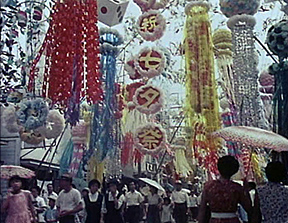
Image Courtesy of National Film Archive of Japan
Photography: Uematsu Eikichi
Music: Mitsukuri Shukichi
Planning: Tohoku Electric Power Co., Inc.
Producer: Okada Sozo
Production Company: Tokyo Cinema Co., Inc.
Source: National Film Archive of Japan
Hachinohe in Aomori Prefecture, where the Tohoku Electric Power Company has constructed a thermoelectric power station, has hosted the summer Sanja Festival since the Edo Period. In Miyagi Prefecture, Sendai also hosts the extravagant Tanabata Festival in the summer, bringing tourism and business to the downtown shopping district. In Hirosaki’s Neputa festival, giant fan-shaped lantern floats are paraded in the streets.
Festivals in Tohoku Part 3
(Tohoku no matsuri: Dai 3 bu)-
1957 / Color / 35mm / 20 min
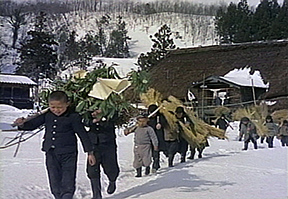 Director, Script: Noda Shinkichi
Director, Script: Noda Shinkichi
Photography: Uematsu Eikichi
Music: Mitsukuri Shukichi
Planning: Tohoku Electric Power Co., Inc.
Producer: Okada Sozo
Production Company: Tokyo Cinema Co., Inc.
Source: National Film Archive of Japan
This film documents scenes from three festival traditions: the series of agricultural rites that take place during the holiday of koshogatsu in the Nishiyokoyama district of Naoetsu City in Niigata Prefecture, the rice planting festivities held to summon the tanokami deity of rice fields and harvests in the Mazawa district of Nishikawa in Yamagata Prefecture, and the energetic Bonden matsuri in Akita Prefecture’s Yokote City, famous for its lavishly decorated bamboo staffs and the vigorous jostling of participants.
Forgotten Land: Record of Life Series II
(Wasurerareta tochi: Seikatsu no kiroku series II)- 1958 / B&W / 16mm / 30 min
Director, Script: Noda Shinkichi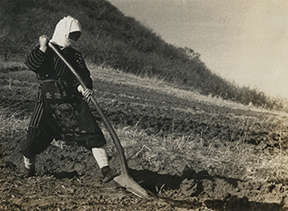
Image Courtesy of National Film Archive of Japan
Photography: Takahashi Yuji
Sound: Ohashi Tetsuya
Music: Mamiya Michio
Narrator: Takashima Akira
Production Company: Tokyo Film
Source: Kobe Planet Film Archive
This film depicts the people living in Shitsukari Village on the Shimokita Peninsula in Aomori Prefecture. Continuing to rely on traditional seafood gathering methods, the men of this village are no match for the fishing boats that trawl the waters off the coast of nearby Iwate Prefecture. The women’s days are consumed with work in the fields. What kind of future can the children of this village hope for as they struggle with poverty?
